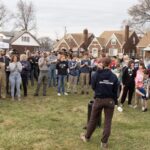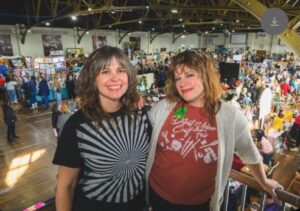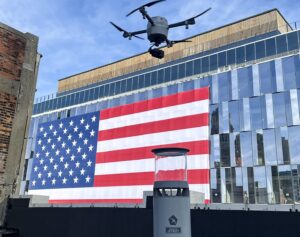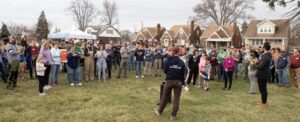Matt Rossetti is a second generation architect, at the helm of ROSSETTI, the firm his father, Gino Rossetti, founded in 1969. While he’s devoted his entire life to design, his first loves were the ocean and not following in his father’s footsteps.
Inspired by his hero, Jacques Cousteau, he studied Oceanography at University of Michigan before the family itch overtook him a year and a half into the program. He swiftly changed his studies to design, sculpture, and architecture.
Most people have one concentration in school—not three.
Most people don’t take a passion for sports and transform it into a career building sports stadiums and arenas.
Since joining the family firm on the late 1980s, Rossetti has built an international brand around his love of the sports and entertainment design, including such clients as The Miami Open, Canadian Tire Center and Arians Hill as well as many hometown favorites—The Palace of Auburn Hills, Ford Field, and Little Ceaser’s Arena, to name a few.
If you don’t know much about architecture or sports, it’s impressive. Like Jacques Cousteau impressive.
While Rossetti’s focus is sports, the firm has a robust firm of diverse clients, both local and international. Around town their projects include Maru, The Corner at the Old Tiger Stadium, Monroe Market, The Albert, and Qline Line stations.
And ROSSETTI HQ, downtown Detroit, where we met up to talk origin, inspiration and city.
Detroitisit: Did you pursue art?
Matt Rossetti: I graduated with a dual degree from undergrad and then took a year off to study sculpture in Florence. It was there that I realized that there were more starving sculptors in Italy than just about anything else—opening my eyes to the fact, that if I liked two things the same, and one could more easily provide a great profession, I would go in that direction.
DII: You joined your father’s firm after that?
MR: No, I went back to grad school. After grad school I moved to NYC for four years and worked for another architect there, with no intention of coming back to Detroit. Because you’re in NY. The coolest place in the world.
It was then that our firm got our first major arena project that was for hockey. I grew up playing hockey. Huge, huge fan. This was for a new arena in the Capital of Canada, Ottawa.

Ford Field Interior, Detroit 2017
DII: This is Rossetti the firm?
MR: Yes, Rossetti. The opportunity to work on an NHL arena was so alluring that I thought I’d work on that and go back to NY.
DII: That’s what you’re most known for, yes? Sports stadiums. Has that always been the case?
MR: My father was an old school architect. To him, a real architect did everything. Once you completed a hospital, then you should go onto an office building. And then after the office building, it should be a house. It goes on and on and on. You don’t follow one track.
The Palace of Auburn Hills was our first such project, and it was a global hit. We revamped the way arenas are arranged with the suites. In classic architecture fashion, my father sort of walked away from that.
When this project [hockey arena] came in the door, I immediately drew an affinity towards the owners, the management, the operations—all the people in the industry are just crazy. They have so much personality. They’re up and down. I relate to them, and these are exciting projects. That’s all I’ve done since I’ve been at the office.
I’ve perpetuated it over the years to the point that we have a global brand in sports and entertainment, but the other face of us, here in Detroit, locally, is anything but sports. It’s mixed use, hospitality, residential, retail urban planning—we cater to a number of different client types here.
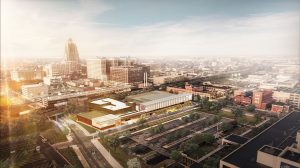
Pistons Performance Center, Detroit
DII: How has the city changed since you returned from NY?
MR: When I moved back here in ’89, it was a ghost town. No exaggeration. Some days you’d see tumbleweeds going down the streets. No cars. No people. It was bizarre here. Like a nuclear bomb had gone off.
And then it had a number of false starts with the stadium projects, the Compuware building. Renaissance Center is another example of these big corporate events that had no infill at the grass roots level.
Then something changed around 2000. The city started to attract more artists, artisans—designers and musicians. There’d be these great parties happening in old buildings that would dissipate the next day. There was movement. Things were happening.
Just about the time Dan [Gilbert] decided to move downtown, it was ripe for corporate development. There was all this stuff happening at the grassroots level. The ground was fertile, and then he came along and planted these big trees.
And the trees took off. Then the bushes. All of a sudden we had this fabulous landscape of culture, art, design, street front, music, business, sports. It was all, for the first time, coming together.

Miami Open
DII: What inspired you as a young architect?
MR: Places that I had traveled to like San Francisco, Seattle, LA San Diego, places in Europe—specifically, Italy—those places emblazoned a strong imprint in my mind, and that has stayed with me.
The way European cities could bring people and cars and food and shopping and cafes all together—out of the stores, out to the sidewalks, into the streets, always intrigued me—and the fact that we could never do it here in the US, with the exception of the last 10-15 years, when human beings realized that cities were important again.
Up until then, all we did was walk away from cities.
DII: How has growing up in Detroit shaped your life and career?
MR: Unfortunately, this city has gone through a terrible racial divide. That was one thing I thought was more common in other big US cities, only to realize, when I came back here, that Detroit was probably the worst in terms of racial divide.
One of the greatest things to happen in the last 10-15 years has been the dialogue that’s started. It’s only been in the last 5-10 years that there’s been a realistic kind of healing and coming together for a vision of collective prosper instead of everyone fighting for the scraps.
Since the mid-1950s Detroit has been in a decline, and I can’t think of any other place that could’ve survived 50 or 60 years of continuous economic and urban and cultural and social decline, and still be alive like this place is.
DII: What’s the role of architecture in this healing?
MR: There’s a spectrum between urban planning and architecture that is critical to bridge, in order to address your question about its role in a city.
So often architects have been trained to essentially look at their footprint and up from there. It has little to do with the sidewalk, the shaping of the streets or how the spaces between the buildings function, and, frankly, as a city person, that’s often more impactful than what the building looks like.
In fact, as you’re cruising through a city—let’s talk about Manhattan—people notice about the first 15-20 feet of a building, and that’s about it. You’ve got your gems and your special buildings and your buildings on vistas, that you may understand or see more, but mid-block buildings are pretty much saturated in the whole jungle of buildings.
My training was as a classical architect. You come down to the sidewalk, and that’s it. What I’ve learned over time, especially in European cities, is the importance of the approach to the building and the spaces around the building. That methodology is critical to rebuilding a city.
DII: In this moment of growth in Detroit, there seems to be a desire for outside influences that’s almost inspirational—wanting something from a bigger city for the sake of being from a bigger city. As a Detroit-based firm, do you think you’ve had to work harder recently to secure local projects?
MR: There’s been so little development going on here for the last thirty years, and it’s been so penny driven that there have been almost no projects. Maybe less than 1% of projects that have been of any great consequence that somebody would even think to look outside of Detroit, that they would go to New York for an architect.
Then, all of a sudden, you’ve got this growth, and it’s sort of like a double-edge sword. Now that there is money. And there is growth. And there’s ROI on these projects—you have developers that are starting to look out and pluck from Chicago, New York …
The Danish firm that’s working in the Monroe Block Project for Gilbert. You have a New York firm doing the Hudson project, and Gachot, another New York-based firm, responsible for the Shinola Hotel.
There are three major projects all done from folks not in this city.
Part of that is, unfortunately, because there has been so little development and almost no residential development. There are very few people with that kind of urban/residential experience, and so we’ve all gotten a little soft here.
I would like to think because we’ve been doing work all over the country—we have massive projects in New York, Miami, Seattle, LA—that we’ve kept our edge sharp and can apply that know-how locally.
DII: What’s next? What are you most excited about?
MR: We have so many amazing projects around the country, and I keep thinking and hoping that I’ll get to work on some of the same quality of projects here, in the city. We’re involved with a lot of planning—master plans and vision plans and concepts and ideas.
DII: In the city?
MR: In the city of Detroit. But it’s so much harder to see them realized than in other cities. We’re doing an unheard of major project, an entertainment piece, in Dallas, Texas. They have investment entities crawling out of the woodwork to invest in this project. Nowhere in your wildest dreams could you get investors in Detroit to fund something like this.
But they’ve got the bodies. They’ve got the money. They’ve got the inertia.
My dream is to see this thing slowly catch on. Dan Gilbert has started this flywheel and this thing is starting to catch on, and we’ve got a lot more revolutions of the flywheel to go before this things starts to get into autopilot.
And then people pile on. ‘Cause that’s the tipping point. Once people stop being curious or skeptical, and they buy in and see the potential—then we’re gonna see this place explode.














